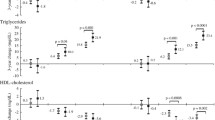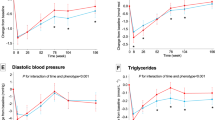Abstract
Introduction: Data on long-term patterns of weight change in relation to the development of metabolic syndrome (MetS) are scarce. The aim of the study was to evaluate the impact of weight change on the risk of MetS in men. Material and Methods: Prospective longitudinal observation (17.9 ± 8.1 years) of apparently healthy 324 men aged 18–64 years. Metabolic risk was assessed in weight gain (⩾ 2.5 kg), stable weight (> −2.5 kg and < 2.5 kg) and weight loss (⩽ −2.5 kg) groups. Adjusted relative risk (RR) of MetS was analyzed using multivariate logistic regression. Results: The prevalence of MetS over follow-up was 22.5%. There was a strong relationship between weight gain and worsening of MetS components among baseline overweight men. Long-term increase in weight was most strongly related with the risk of abdominal obesity (RR=7.26; 95% CI 2.98–18.98), regardless of baseline body mass index (BMI). Weight loss was protective against most metabolic disorders. Leisure-time physical activity (LTPA) with energy expenditure > 2000 metabolic equivalent/min/week was associated with a significantly lower risk of MetS. Conclusions: Reducing weight among overweight and maintaining stable weight among normal-weight men lower the risk of MetS. High LTPA level may additionally decrease the metabolic risk regardless of BMI.
Similar content being viewed by others
References
Third Report of the National Cholesterol Education Program (NCEP), Expert Panel on Detection, Evaluation, and Treatment of High Blood Cholesterol in Adults final report, Circulation, 2002, 106, 3143–421
Gami A.S., Witt B.J., Howard D.E., Erwin P.J. Gami L.A., Somers V.K. et al., Metabolic syndrome and risk of incident cardiovascular events and death: a systematic review and meta-analysis of longitudinal studies, J Am Coll Cardiol 2007, 49, 403–14
Ärnlöv J., Ingelsson E., Sundström J., Lind L., Impact of body mass index and the metabolic syndrome on the risk of cardiovascular disease and death in middle-aged men, Circulation, 2010, 121, 230–236
Ferrannini E., Haffner S.M., Mitchell B.D., Stern M.P., Hyperinsulinaemia: the key feature of a cardiovascular and metabolic syndrome, Diabetologia, 1991, 34, 416–422
Carr D.B., Utzschneider K.M., Hull R.L. et al., Intra-abdominal fat is a major determinant of the National Cholesterol Education Program Adult Treatment Panel III criteria for the metabolic syndrome, Diabetes, 2004, 53, 2087–2094
Kwaśniewska M., Kaleta D., Dziankowska-Zaborszczyk E., Drygas W., Healthy behaviours, lifestyle patterns and sociodemographic determinants of the metabolic syndrome, Central Eur. J. Public Health, 2009, 17, 14–19
Wyrzykowski B., Zdrojewski T., Sygnowska E. et al., Epidemiology of the metabolic syndrome In Poland. Results of the WOBASZ Project, Polish Heart J., 2005, 63, 41–44
Mokdad A.H., Ford E.S., Bowman B.A., et al., Prevalence of obesity, diabetes, and obesity-related health risk factors, 2001, JAMA, 2003, 289, 76–79
Park Y.W., Zhu S., Palaniappan L., Heshka S., Carnethon M.R., Heymsfield S.B., The metabolic syndrome: prevalence and asscociated risk factors findings in the US population from the Third National Health and Nutrition Examination Survey, 1988–1994, Arch. Intern. Med., 2003, 163, 427–436
Vergnaud A.C., Bertrais S., Oppert J.M. et al., Weight fluctuations and risk for metabolic syndrome in adult cohort, Int. J. Obes., 2008, 32, 307–326
Lloyd-Jones D.M., Liu K., Colangelo L.A., et al., Consistently stable or decreased body mass index in young adulthood and longitudinal changes in metabolic syndrome components: the Coronary Artery Risk Development in Young Adults Study, Circulation, 2007, 115, 1004–1011
Hillier T.A., Fagot-Campagna A., Eschwège E., Vol S., Cailleau M., Balkau B., and he D.E.S.I.R. Study group, Weight change and changes in the metabolic syndrome as the French population moves towards overweight: The D.E.S.I.R. Cohort, Int. J. Epidemiol., 2006, 35, 190–196
Zabetian A., Hadaegh F., Sarbakhsh P., Azizi F., Weight change and incident metabolic syndrome in Iranian men and women: a 3 year follow-up study, BMC Public Health, 2009, 9, 138
Bot M., Spijkerman A.M.W., Twisk J.W.R., Verschuren W.M.M., Weight change over five-year periods and number of components of the metabolic syndrome in a Dutch cohort, Eur. J. Epidemiol., 2010, 25, 125–133
Everson S.A., Goldberg D.E., Helmrich S.P. et al., Weight gain and the risk of developing insulin resistance syndrome, Diabetes Care, 1998, 21, 137–143
Carnethon M.R., Loria C.M., Hill J.O., Sidney S., Savage P.J., Liu K., Risk factors for the metabolic syndrome: the Coronary Artery Risk Development in Young Adults (CARDIA) study, 1985–2001, Diabetes Care, 2004, 27, 2707–2715
Kaleta D., Kwaśniewska M., Bednarek-Gejo A., et al., Body weight change and health outcomes in middle-aged men—a prospective study results, Przegl, Lek,, 2005, 62, 18–22, (in Polish)
Ainsworth B.E., Haskell W.L., Leon A.S., Jacobs D.R. Jr., Montoye H.J., Sallis J.F., Paffenbarger R.S. Jr., Compendium of physical activities: classification of energy costs of human physical activities, Med. Sci. Sports Exerc., 1993, 25, 71–80
Onat A., Uyarel H., Hergenç G., Karabulut A., Albayrak S., Can G., Atherosclerosis, 2007, 191, 182–190
Yang F.Y., Wahlqvist M.L., Lee M.S.,. Body mass index (BMI) as a major factor in the incidence of the metabolic syndrome and its constituents in unaffected Taiwanese from 1998 to 2002, Asia Pac. J. Clin. Nutr., 2008, 17, 339–351
Zanchetti A., Hennig M., Baurecht H., Tang R., Cuspidi C., Carugo S., Mancia G., Prevalence and incidence of the metabolic syndrome in the European Lacidipine Study on Atherosclerosis (ELSA) and its relation with carotid intima-media thickness, J. Hypertens., 2007, 25, 2463–2470
Drygas W., Kostka T., Jegier A., et al., Long-term effects of different physical activity models on coronary heart disease risk factors in middle-aged men, Int. J. Sports Med., 2000, 21, 235–241
Laaksonen D.E., Lakka H.M., Salonen J.T., et al., Low levels of leisure-time physical activity and cardiorespiratory fitness predict development of the metabolic syndrome, Diabetes Care, 2002, 25, 1612–1618
Holme I., Tonstad S., Sogaard A.J., et al., Leisure time physical activity in middle age predicts the metabolic syndrome in old age: results of a 28-year follow-up of men in the Oslo study, BMC Public Health, 2007, 12, 154
Li C.L., Lin J.D., Lee S.J., Tseng R.F., Associations between the metabolic syndrome and its components, watching television and physical activity, Public Health, 2007, 121, 83–91
Drygas W., Jegier A., Bednarek-Gejo A., Kwaśniewska M., Dziankowska-Zaborszczyk E., Kostka T., Physical activity volume as a key factor influencing obesity and metabolic syndrome prevalence in middle-aged men. Long-term prospective study, Przegl. Lek., 2005, 62, 8–13, (in Polish)
Case C.C., Jones P.H., Nelson K., O’Brian Smith E., Ballantyne C.M., Impact of weight loss on the metabolic syndrome, Diabetes Obes. Metab., 2002, 4, 407–414
Sjöström L., Lindroos A.K., Peltonen M., et al., Lifestyle, diabetes, and cardiovascular risk factors 10 years after bariatric surgery, N. Engl. J. Med., 2004, 351, 2683–2693
Drygas W., Kwaśniewska M., Kaleta D., Pikala M., Bielecki WE., Głuszek J., et al., Epidemiology of physical inactivity in Poland: prevalence and determinants in a former communist country in socioeconomic transition, Public Health, 2009, 123, 592–597
Kwaśniewska M., Kaczmarczyk-Chałas K., Pikala M., Broda G., Kozakiewicz K., Pająk A., et al., Commuting physical activity and prevalence of metabolic disorders in Poland, Prev. Med., 2010, 51, 482–427
Author information
Authors and Affiliations
Corresponding author
About this article
Cite this article
Kwaśniewska, M., Kaleta, D., Jegier, A. et al. The weight change impact on metabolic syndrome: a 17-year follow-up study. cent.eur.j.med 6, 788–794 (2011). https://doi.org/10.2478/s11536-011-0093-2
Received:
Accepted:
Published:
Issue Date:
DOI: https://doi.org/10.2478/s11536-011-0093-2




